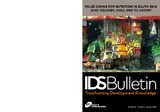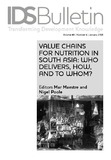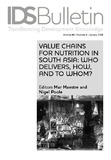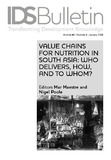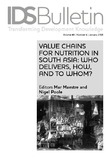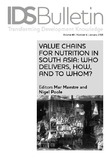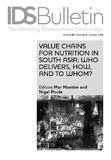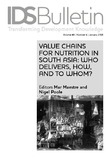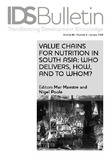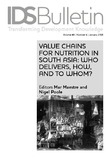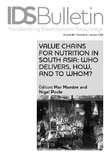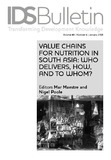Volume 49. Issue 1: Value Chains for Nutrition in South Asia: Who Delivers, How, and to Whom?
Browse by
Recent Submissions
-
Value Chains for Nutrition in South Asia: Who Delivers, How, and to Whom?
(Institute of Development Studies, 2018-01-31)There is currently much talk of the private sector role in nutrition, and whether the state can ‘shape’ the market to deliver better nutritional outcomes. This issue of the IDS Bulletin presents research findings in this ... -
Introduction: Value Chains for Nutrition in South Asia: Who Delivers, How, and to Whom?
(Institute of Development Studies, 2018-01-31)There is currently much talk of the private sector role in nutrition, and whether the state can better ‘shape’ the market to deliver nutritional outcomes. This article introduces an issue of the IDS Bulletin which ... -
Notes on Contributors: Value Chains for Nutrition in South Asia: Who Delivers, How, and to Whom?
(Institute of Development Studies, 2018-01-31)This is the notes on contributors for IDS Bulletin 49.1, '‘Value Chains for Nutrition in South Asia: Who Delivers, How, and to Whom?’ -
Glossary: Value Chains for Nutrition in South Asia: Who Delivers, How, and to Whom?
(Institute of Development Studies, 2018-01-31)This is the glossary of IDS Bulletin 49.1, 'Value Chains for Nutrition in South Asia: Who Delivers, How, and to Whom?’. -
Focus on Gender, Context, and Evidence: CARE’s Lessons Learned
(Institute of Development Studies, 2018-01-31)This article explores the most effective ways to influence nutrition through value chains, based on CARE’s long history in food and nutrition security. With implementation experience in 90 countries and evidence from 11 ... -
A Study on Milk Value Chains for Poor People in Bangladesh
(Institute of Development Studies, 2018-01-31)Child and maternal undernutrition is still prevalent in Bangladesh and poor dietary diversity is one of the major causes. While milk can contribute to nutritional requirements, currently availability in Bangladesh is ... -
Building Dairy Value Chains in Badakhshan, Afghanistan
(Institute of Development Studies, 2018-01-31)Considerable recent research has tried to link agricultural production and the distribution of nutrient-rich foods to consumption, and hence improved health, of nutritionally vulnerable population groups. However, we are ... -
‘Milk for Milk, Water for Water’: Analysing Pakistan’s Dairy Innovation
(Institute of Development Studies, 2018-01-31)Interventions in agri-food value chains are thought to potentially make important contributions towards enhancing agriculture’s role in nutrition. Some frameworks have begun to identify sets of requirements for pro-nutrition ... -
Food Distribution Value Chains under the Integrated Child Development Services
(Institute of Development Studies, 2018-01-31)Globally, social provisioning of food is recognised as an important means to reduce the prevalence of malnutrition. Government food distribution programmes have potential for impact at scale in this context. This article ... -
Going Against the Grain of Optimism: Flour Fortification in Pakistan
(Institute of Development Studies, 2018-01-31)Food fortification is a popular strategy for addressing ‘hidden hunger’, and staple foods are seen as promising, if unproven, vehicles for the delivery of essential micronutrients to poor people in developing countries. ... -
Business-Based Strategies for Improved Nutrition: The Case of Grameen Danone Foods
(Institute of Development Studies, 2018-01-31)There is increasing interest in the role that businesses can play in promoting the consumption of nutrient-dense foods as part of strategies to reduce the prevalence of micronutrient deficiencies in developing countries. ... -
Private Business-Driven Value Chains and Nutrition: Insights from India
(Institute of Development Studies, 2018-01-31)Despite rapid economic growth, undernutrition rates in South Asia remain among the highest in the world. It is also seen that both rural and urban populations in developing countries are increasingly dependent on markets ...

